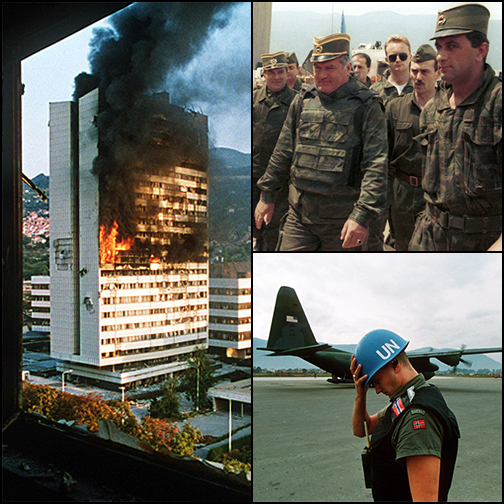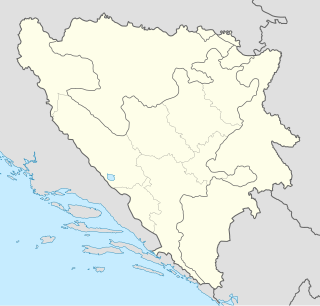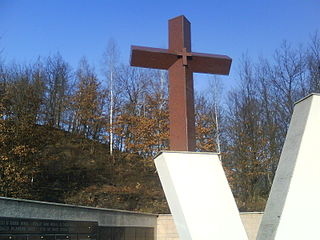Tihomir Blaškić is a retired general of the Croatian Defence Council (HVO) who served during the Bosnian War and the Croat–Bosniak War. The International Criminal Tribunal for the Former Yugoslavia (ICTY) indicted him on war crimes charges and in 2000 he was sentenced to 45 years of prison. In July 2004, the ICTY, on appeal, determined that his command responsibility for most of the charges was non-existent and his sentence was lessened to nine years imprisonment. He was released the following month.

The Bosnian War was an international armed conflict that took place in Bosnia and Herzegovina between 1992 and 1995. The war is commonly seen as having started on 6 April 1992, following a number of earlier violent incidents. The war ended on 14 December 1995. The main belligerents were the forces of the Republic of Bosnia and Herzegovina and those of Herzeg-Bosnia and Republika Srpska, proto-states led and supplied by Croatia and Serbia, respectively.
The Bosnian War attracted large numbers of foreign fighters and mercenaries from various countries. Volunteers came to fight for a variety of reasons including religious or ethnic loyalties, but mostly for money. Generally, Bosniaks received support from Muslim countries, Serbs from Eastern Orthodox countries, and Croats from Catholic countries. The numbers, activities and significance of the foreign fighters were often misrepresented. However, none of these groups constituted more than five percent of any of the respective armies' total manpower strength.
Dario Kordić is a Bosnian Croat former politician from the Croatian Democratic Union of Bosnia and Herzegovina, military commander of the Croatian Defence Council (HVO) between 1992 and 1994, vice president of the Croatian Republic of Herzeg-Bosnia, a self-proclaimed Croat territory in Bosnia and Herzegovina and convicted war criminal. He was sentenced to 25 years in prison in February 2001 for war crimes committed against the Bosniak population during the 1992–94 Bosniak-Croat war, and was released in June 2014 after having served two thirds of his sentence.

The Ahmići massacre was the culmination of the Lašva Valley ethnic cleansing committed by the Croatian Community of Herzeg-Bosnia's political and military leadership on Bosniak civilians during the Croat-Bosniak War in April 1993. It was the largest massacre committed during the conflict between Bosnian Croats and the Bosniak-dominated Bosnian government.

Operation Mistral 2, officially codenamed Operation Maestral 2, was a Croatian Army (HV) and Croatian Defence Council (HVO) offensive in western Bosnia and Herzegovina on 8–15 September 1995 as part of the Bosnian War. Its objective was to create a security buffer between Croatia and positions held by the Bosnian Serb Army of Republika Srpska (VRS) and to put the largest Bosnian Serb-held city, Banja Luka, in jeopardy by capturing the towns of Jajce, Šipovo and Drvar. The combined HV and HVO forces were under the overall command of HV Major General Ante Gotovina.

Operation Neretva '93 was an Army of the Republic of Bosnia and Herzegovina (ARBiH) operation against the Croatian Defence Council (HVO) in September 1993 on a 200 km long front from Gornji Vakuf to south of Mostar, one of its largest of the year, during the Croat–Bosniak War. The ARBiH made limited gains in the area of northern Herzegovina and around Mostar, but did not achieve a breakthrough to the southern Neretva, where the HVO retained control. The operation was halted in October. During the operation, dozens of Croat civilians were killed in the Grabovica and Uzdol massacres.

The Lašva Valley ethnic cleansing, also known as the Lašva Valley case, refers to numerous war crimes committed during the Bosnian war by the Croatian Community of Herzeg-Bosnia's political and military leadership on Bosnian Muslim (Bosniak) civilians in the Lašva Valley region of Bosnia-Herzegovina. The campaign, planned from May 1992 to March 1993 and erupting the following April, was meant to implement objectives set forth by Croat nationalists in November 1991. The Lašva Valley's Bosniaks were subjected to persecution on political, and religious grounds, deliberately discriminated against in the context of a widespread attack on the region's civilian population and suffered mass murder, rape, imprisonment in camps, as well as the destruction of cultural sites and private property. This was often followed by anti-Bosniak propaganda, particularly in the municipalities of Vitez, Busovača, Novi Travnik and Kiseljak.

The Croat–Bosniak War was a conflict between the Republic of Bosnia and Herzegovina and the self-proclaimed Croatian Republic of Herzeg-Bosnia, supported by Croatia, that lasted from 18 October 1992 to 23 February 1994. It is often referred to as a "war within a war" because it was part of the larger Bosnian War. In the beginning, Bosniaks and Croats fought in an alliance against the Yugoslav People's Army (JNA) and the Army of Republika Srpska (VRS). By the end of 1992, however, tensions between Bosniaks and Croats increased. The first armed incidents between them occurred in October 1992 in central Bosnia. Their military alliance held out until early 1993 when their cooperation fell apart and the two former allies engaged in open conflict.

Operation Corridor 92 was the largest operation conducted during the Bosnian War by the Army of Republika Srpska (VRS) against the forces of the Croatian Defence Council (HVO) and the Croatian Army (HV) in the Bosanska Posavina region of northern Bosnia and Herzegovina between 24 June and 6 October 1992. The objective of the offensive was to re-establish a road link between the city of Banja Luka in the west of the country and the eastern parts of the territory controlled by the Bosnian Serbs. The offensive was prompted by the capture of Derventa by the HV and the HVO – a move that blocked the single overland road between the VRS-controlled territories.
The Trusina massacre occurred on 16 April 1993 in the village of Trusina, located in the municipality of Konjic in Bosnia and Herzegovina, where 22 people, four Croat soldiers and 18 Croat civilians, were killed by the Army of the Republic of Bosnia and Herzegovina (ARBiH) during the Croat–Bosniak War.

The Croat–Bosniak War was a conflict between the Republic of Bosnia and Herzegovina and the Croatian Community of Herzeg-Bosnia, supported by Croatia, that lasted from 19 June 1992 – 23 February 1994. The Croat-Bosniak War is often referred to as a "war within a war" because it was part of the larger Bosnian War.
The Stupni Do massacre was a massacre committed by Croatian forces on Bosniak civilians during the Croat–Bosniak war in the village of Stupni Do in Vareš municipality. It was committed on 23 October 1993 by Croatian Defence Council (HVO) units called "Apostoli" and "Maturice" led by Ivica Rajić, who pleaded guilty before ICTY for war crimes in October 2005. The Croat forces took control of the village and massacred most of the captured people. They raped the women before killing them and looted all houses before setting them on fire. The confirmed number of victims is at least 37.

The Križančevo selo massacre occurred in Križančevo selo, a hamlet in the Lašva Valley in central Bosnia, where at least 14 Croat POWs and civilians were killed during an attack by the Army of the Republic of Bosnia and Herzegovina (ARBiH) on Croatian Defence Council (HVO) positions on 22 December 1993.

The Siege of Bihać was a three-year-long siege of the northwestern Bosnian town of Bihać by the Army of the Republika Srpska, the Army of the Republic of Serbian Krajina and Bosniak dissenters led by the Bosniak politician Fikret Abdić during the 1992–95 Bosnian War. The siege lasted for three years, from June 1992 until 4–5 August 1995, when Operation Storm ended it after the Croatian Army (HV) overran the rebel Serbs in Croatia and northwest of the besieged town.

The siege of Mostar was fought during the Bosnian War first in 1992 and then again later in 1993 to 1994. Initially lasting between April 1992 and June 1992, it involved the Croatian Defence Council (HVO) and the Army of the Republic of Bosnia and Herzegovina (ARBiH) fighting against the Serb-dominated Yugoslav People's Army (JNA) after Bosnia and Herzegovina declared its independence from Yugoslavia. That phase ended in June 1992 after the success of Operation Jackal, launched by the Croatian Army (HV) and HVO. As a result of the first siege around 90,000 residents of Mostar fled and numerous religious buildings, cultural institutions, and bridges were damaged or destroyed.
The Battle of Bugojno was fought between forces of the Army of the Republic of Bosnia and Herzegovina (ARBiH) and the Croatian Defence Council (HVO) for control of the town and municipality of Bugojno in central Bosnia, from 18–28 July 1993. The area of Bugojno was under joint control of the ARBiH 307th Brigade and the HVO Eugen Kvaternik Brigade since the start of the Bosnian War. Violent incidents in Bugojno followed the escalation of the Croat-Bosniak War in adjacent municipalities throughout the 1st half of 1993. Bugojno was spared from fighting and the two local brigades were still formally allied by June 1993, at the time of an ARBiH offensive in central Bosnia.
The Bradina massacre is the mass murder of at least 48 Bosnian Serb civilians by joint Bosniak and Bosnian Croatian forces on May 25, 1992 in the village of Bradina, located in the municipality of Konjic, during the Bosnian war.
The Zenica massacre happened on 19 April 1993, approximately about noon. Several grenades shot from HVO's positions located in Putićevo village, about 16 km (9.9 mi) west of Zenica, killed 16 and injured over 50 civilians amid large crowd gathered.
Operation Bura was a joint offensive conducted by the Croatian Defence Council and the Army of the Republic of Bosnia and Herzegovina with help from the Croatian Army and numerous Mujahideen formations on the territories held by the Nevesinje and Bileća brigades of the Army of Republika Srpska during the Bosnian War.









